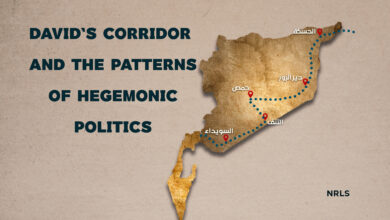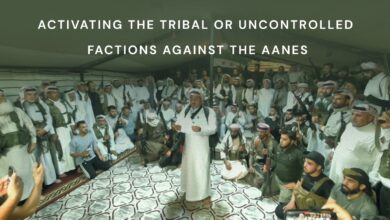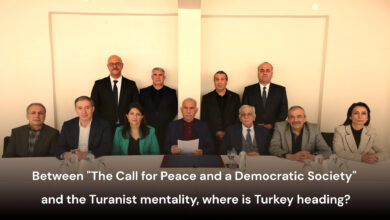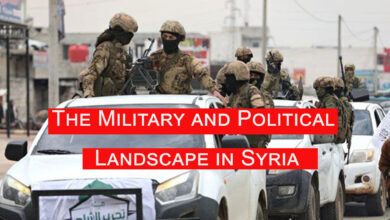SDF and the War of the Three Fronts
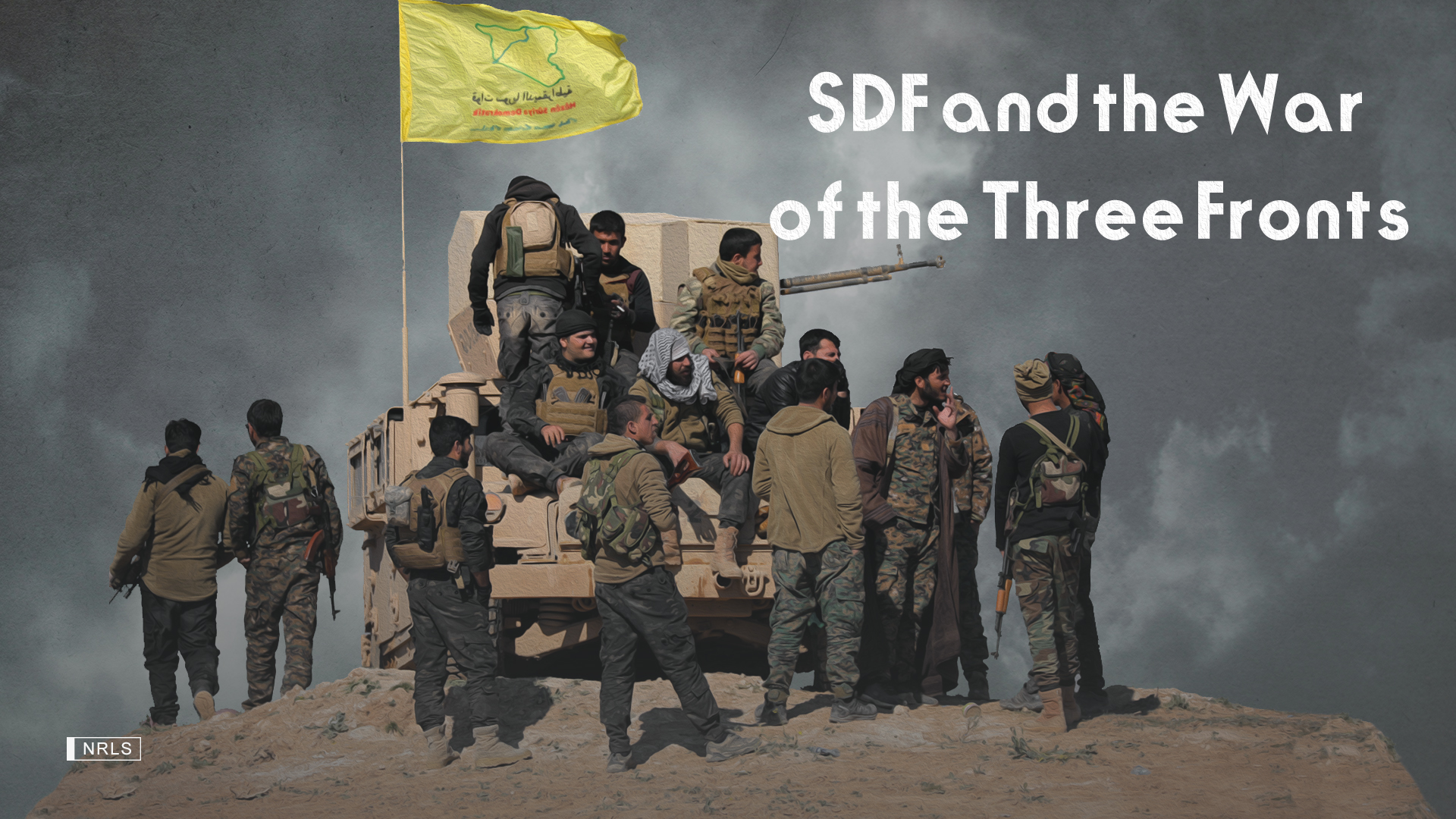
After more than a decade since its outbreak, the Syrian crisis is witnessing signs of a new political and security situation. This change is marked by Turkey’s dramatic shift in its stance towards normalization with the Syrian regime, as well as the suspicious absence of Iran from the political scene of this crisis after enduring blows that have destabilized its leadership, despite its attempts to project calm. Additionally, Russia seems to play a role in both the shift and the absence (*[1]), with two clear objectives: first, to resolve the Syrian crisis in favor of the regime and thus secure the Eastern Mediterranean front, which impacts its position in Ukraine. The second objective is to gain control over the resources of northern and eastern Syria to benefit the Russian economy, which is suffering under the weight of Western sanctions and the war in Ukraine. This control also aims to offset the costs of its military intervention in Syria, along with other benefits such as undermining American influence in the region through Turkey and Iran, both of which share a common goal with the Ba’ath Party to eradicate the Kurdish issue in accordance with their nationalist and sectarian ideologies.
Based on this, it can be stated that northern and eastern Syria are experiencing a hybrid war formed by the convergence of conflicting ideologies with shared motives among five powers facing internal crises (Turkey, Russia, Iran, the Syrian regime, and ISIS). These powers view the Autonomous Administration of northern and eastern Syria and the Syrian Democratic Forces (SDF) as the reason for their struggles and a symbol of their ideological projects’ failures in northern Syria. Thus, it has become clear that undermining the Autonomous Administration and eliminating the SDF is a common goal for these five forces. Concurrently, all of them seek to control the region’s resources, with each party aiming for full control or at least the largest share possible to secure additional funding for their activities in the region. Consequently, these two objectives are among the main reasons the SDF is engaged in a defensive war on three fronts.
- Northern Front: The military operations in this region are characterized by resistance against the attacks from the Turkish occupation army and its mercenaries on the northern side of the regions of Jazeera, Euphrates, Manbij, Raqqa, and Shahba.
- Western Front: The military operations here involve confronting the attacks from the Syrian regime forces and their mercenaries in the regions of Deir Al-Zor and Raqqa, as well as countering the conspiratorial operations (*[2]) of intelligence management rooms (Russian, Iranian, Baathist) in both Hasaka and Qamishli.
- Domestic Front: The military operations in this area focus on combating attacks from ISIS cells targeting civilian sites and military points in the rural areas of Hasaka, Deir Al-Zor, and Raqqa.
Consequently, the military and security scene in these fronts can be primarily divided between attacking parties using varied methods (represented by Turkey, ISIS, the Syrian regime, Iran, and Russia) and a defending party (represented by the Syrian Democratic Forces and the Autonomous Administration).
▪ Dynamics of conflict in the three fronts:
Based on the observed synchronization in operational activities among the three fronts, it has become evident that the attacking parties are coordinating their operations directly and sometimes indirectly. This is achieved when one of the forces adopts a combat tactic that parallels and coincides with the attacks occurring on one of the fronts. For instance, ISIS has intensified its attacks (*[3]) against civilian and military targets in northern and eastern Syria using explosive devices and conducting operations in al-Hol camp in conjunction with severe Turkish bombardment (*[4]) of infrastructure and service facilities in northern and eastern Syria at the beginning of 2024. This is also in tandem with the increased assaults by the Syrian regime’s “Tribal Forces” (*[5]) on civilian and military targets in Deir Al-Zor province.
The most significant indicators of direct coordination are reflected in the sabotage operations targeting civilian and military sites in Deir Al-Zor province during the summer of 2023. This was highlighted by the intersecting statements from the foreign ministers of both the Turkish and Syrian regimes, as reported by Russian news agencies. The Syrian Foreign Minister (Faisal Mekdad) claimed to the Russian news agency Sputnik (*[6]) that there is “Damascus’s support for the Arab tribes in the rural areas of Deir Al-Zor province in their fight against the U.S.-backed forces in eastern Syria.” Furthermore, the Turkish Foreign Minister (Hakan Fidan) was quoted by the RT channel (*[7]) alleging, “The policy of repression, especially against Arabs in Syria by the YPG [the Turkish designation for the Syrian Democratic Forces], must come to an end,” indicating that the People’s Protection Units, supported by the U.S., had invaded Arab territories and subjugated them. This assertion comes despite the fact that the Deir Al-Zor Military Council and the Hajin Military Council in the area mainly consist of members from the local tribes.
On the other hand, although Russian forces are considered one of the guarantors of the ceasefire in northern and eastern Syria between the Syrian Democratic Forces and the Turkish occupation army following the occupation of Sere Kaniye/Ras al-Ain and Tal Abyad/Gire Sipi in the summer of 2019, they do not take any action to stop Turkish assaults on the region. This lack of action was clearly demonstrated during the extensive and unjustified Turkish bombardment of infrastructure and service facilities in northern and eastern Syria. Consequently, it appears that the Russians have an interest in the destruction of northern and eastern Syria as long as they do not control the region’s resources, and the same applies to Iran. This is further evidenced by recent Russian efforts to normalize relations between the Turkish and Syrian regimes, as well as the systematic attacks by Turkish extremists on Syrian refugees in the southwestern provinces of Turkey. According to official Turkish statements and protests against the recent Turkish position on the Syrian crisis, the aim of these efforts and assaults is to create a pretext to renege on the promises Erdoğan made to the Syrian opposition that supports him, gradually disposing of them.
In political terms, the Autonomous Administration and the Syrian Democratic Council have been excluded from participating in most discussions and meetings aimed at resolving the Syrian crisis in Astana, Sochi, or Moscow. They were also not invited to join the meetings of the Constitutional Committee in Geneva. As a result, the attacking forces imposed a political blockade on northeastern Syria, bolstering their efforts in three fronts. This has led to a relative isolation of northeastern Syria from the broader Syrian geopolitical scene.
On the other hand, the attacking forces are engaged in an indirect conflict among themselves; the Turkish occupying army continues to support the attacks carried out by factions loyal to it against the forces of the Damascus government. Its military positions in the southern Idlib countryside still create a barrier between Jabhat al-Nusra and those referred to as Caucasian jihadists (enemies of Moscow and the Syrian regime). This region has even become a source of drone attacks on “Hmeimim Air Base,” the largest Russian base in Syria, as well as the bloody assault during a graduation ceremony for students at a military academy in Homs on October 5, 2023, which resulted in over 80 deaths (including civilians) and injuries to dozens more. ISIS elements continue to operate in areas occupied by Turkey, where the organization conducted several attacks within Russia and against Syrian regime forces and Shiite militias in the desert during June. Aleppo, controlled by Iranian-backed forces, remains a target for Turkish occupation, as Erdoğan considers it an essential part of the “national pact,” while Iranian Shiites view it as one of the centers of Shiism (*[8]) before it fell under the control of the Seljuks and later the Ottomans. Additionally, for Russia, the presence of NATO-aligned forces near its strategic bases on the Syrian coast is unacceptable. Its war in Ukraine is based on this principle; thus, it cannot be confirmed that there is a strategic agreement among the attacking forces. Instead, there are tactical agreements focused on pitting adversaries against each other based on their shared animosity toward the Syrian Democratic Forces and the Autonomous Administration, and the conflict is managed on this basis.
Thus, the dynamics of the conflict on the three fronts can be defined as a set of tactics that have military, security, political, and economic dimensions. These involve assassination operations, targeting military assets, bombarding essential facilities for the population’s survival, undermining the service institutions of the Autonomous Administration, and inciting local communities against it. This is achieved through groups such as the Muslim Brotherhood, Ba’athists, ISIS affiliates, and certain factions of the Kurdish National Council, along with the infiltration of organized intelligence cells into service institutions to disrupt their functions concerning the community. These tactics are supported by a systematic media campaign of defamation and incitement against the Autonomous Administration and the Syrian Democratic Forces, aiming to provoke discord among various components and rally local communities against the institutions of the Autonomous Administration. In addition, there is a continuous effort to isolate the region from policies related to resolving the Syrian crisis, similar to discussions and agreements reached in the Astana and Sochi talks, as well as the meetings of the Constitutional Committee.
On the other hand, the defending entity is considered an adept competitor in managing the crises caused by the attacking entities. It possesses a defensive strategy that remains resilient against the expertise and capabilities of the aggressors. This serves as an indicator of the autonomous administration and the Syrian Democratic Forces’ ability to address various threats, challenges, and attacks. Analyzing the strength upon which the defending entity relies in its defensive operations reveals that it is based on both community diplomacy and military diplomacy (partnership with the international coalition and memorandums of understanding with Russian forces established in 2019). Through community diplomacy, it maintains internal cohesion and counters attempts to “bring down the fortress from within.” Meanwhile, military diplomacy provides a barrier against any ground invasion of the region. This defensive strategy is further reinforced by the intense conflict between the aggressors and the Western bloc present in the area under the guise of the international coalition to combat terrorism. Additionally, the ideological and political propositions of the democratic nation that the Syrian Democratic Forces adhere to do not contradict human and ethical values in international law, humanitarian law, or human rights charters. They pose no threat to countries described as democratic, nor do they threaten the culture of local communities. This situation does not provide any justification for direct international silence towards a complete invasion of the region by the Turkish, Russian, or Iranian regimes.
The possession of significant military, economic, political, and intelligence capabilities by the attacking parties, compared to the defensive side’s capacities, raises the following question: Why aren’t these fronts being decisively resolved? Certainly, there are factors behind this that relate to the geopolitical situation in the Middle East. Despite the contradictions or agreements among the influential powers in the Syrian crisis, and even though the attacking forces share a rejection of the political and social scene in Northern and Eastern Syria, it is impossible to predict that the military operations on the three fronts will continue to follow a fixed course; pragmatism governs the relations between states (*[9]). This has become evident in Turkey’s changing stance towards Syria, to the point that the Syrian Democratic Forces (*[10]) had previously announced their readiness to engage in dialogue with any party in the region to ease tensions. This indicates that the governing systems in these countries may resort to a form of balance between their ideologies and material interests to avoid an ideological rift within their systems due to economic, political, and military pressures. Based on this, it is possible to highlight, in general, the main factors and underlying reasons for the lack of resolution on the three fronts from a realistic perspective:
- The inability to unify fronts against the Syrian Democratic Forces:
The attacking parties have so far failed to launch a concentrated, decisive, and public assault on northern and eastern Syria. This failure is primarily due to a lack of trust and the inability to build confidence through an inclusive path, as there are ideological contradictions among them. Each group has its own political agenda and economic crises, and no party wants to lose or provide advantages to a current partner who may later become a rival. Ultimately, power and pragmatism will govern their relationships.
- The failure to undermine the community and military diplomacy of the defending side:
Most psychological warfare, extremist ideological propaganda, threats, and sabotage operations within northern and eastern Syria have not succeeded in inciting local communities against the Syrian Democratic Forces and the Autonomous Administration. According to all the citizens, intellectuals, politicians, and fighters interviewed from various Kurdish, Arab, and Assyrian backgrounds, the Autonomous Administration and the Syrian Democratic Forces are considered the best option for their human security. They are fully aware of the absence of national principles in the Syrian regime, which has not changed its repressive security mentality. This is evidenced by the ongoing assassination campaigns in Daraa since the security settlements with local factions in 2018, as well as the popular protests in As Suwayda over the past ten months and the unethical treatment citizens receive at the Syrian regime’s security checkpoints. Additionally, there are thousands of victims, missing persons, and displaced individuals at the hands of this regime.
Regarding the Turkish regime, the experience of relying on it is evident in the areas it has occupied in northern and northwest Syria. This is manifest in its forced displacement operations aimed at creating demographic changes by establishing settlements in the occupied regions, particularly in Afrin (*[11]), along with the forcible relocation of thousands of Syrian refugees to these areas. Additionally, there are ongoing violations committed by the factions affiliated with it, who exploit individuals as mercenaries (*[12]) in Turkey’s external wars, along with racist assaults by extremist Turks against Syrians residing in and fleeing to Turkey, and the systematic Turkification policies imposed on them.
As for Iran, its ideology and political project face significant rejection from local communities in northern and eastern Syria, whether from Sunnis, secularists, democrats, or even nationalists. Iran has turned Syria into a front for its regional conflict, at the cost of the suffering of the Syrian people. Meanwhile, Russia is viewed by the majority of Syrians as a contributor to the ongoing crisis and a partner of the Syrian regime in most of its massacres. ISIS has become a common enemy of local communities and a symbol of the evil that has plagued these societies, taking on a negative place in the collective memory of the region. Local communities, despite criticism directed at the Autonomous Administration’s institutions, are fully aware of the responsibility of the attacking parties for the deterioration of living and service conditions in northern and eastern Syria.
On another note, the international coalition has repeatedly announced its continued support for the Syrian Democratic Forces in the fight against ISIS and its rejection of all Turkish pressures (*[13]) to end its relations and backing of these forces. However, the representatives of the Autonomous Administration and the Syrian Democratic Council continue to engage in diplomatic activities in many countries that have not bowed to Turkish pressure to close them.
- The lack of any party among the attacking forces having the audacity to wage a conventional war independently against North and East Syria and to invade and control it: The Syrian Democratic Forces do not possess the capabilities to engage in conventional warfare, and there is no moral deterrent in the military doctrine of the attacking parties that would prevent them from invading the region and destroying cities and towns with their inhabitants. The atrocities committed in Eastern Ukraine, the chemical bombardment in Douma and Khan Sheikhoun, the use of barrel bombs and vacuum missiles, and the massacres and violations that occurred in Aleppo, Idlib, Hama, Homs, the Damascus countryside, Daraa, Deir Al-Zor, Afrin, Ras al-Ain/Sere kaniye, Mosul, Raqqa, and others testify to this. Despite this, the attacking parties do not have the audacity to invade the area alone, as the region constitutes a theater for strategic military operations of the international coalition in the fight against ISIS in partnership with the Syrian Democratic Forces and Internal Security Forces (Asayish). This leads us to believe that the attacking parties recognize they lack the ability to directly undermine the creative chaos strategy of the Western pole (destruction and rebuilding of the geopolitical situation) specific to the Middle East, which seems to have been established in the early years of this century. Even the strategic competition or ideological conflict among the attacking parties sometimes shifts to become tools serving this strategy. This can be observed when analyzing the crises primarily affecting Syria, Iraq, Turkey, Lebanon, Israel, Palestine, and Iran, along with related initiatives to open trade routes, establish military corridors, and changes in geopolitical dynamics.
Upon examining most of the research from Western study centers concerning Northern and Eastern Syria, it is noticeable that the Syrian Democratic Forces (SDF) have become an influential player in the regional situation, placing them in a position to be a significant factor in the regional political and security equations. Many Arab and Western countries, along with democratic forces and the Kurdish people, are very concerned about not allowing Turkey, Iran, Russia, or ISIS to dominate Northern and Eastern Syria. This suggests that the SDF is positioning itself to become a regional actor that cannot be easily removed from the political, security, and military scene in the area. This may be one of the reasons for the protracted nature of the battles across the three fronts.
In a related context, the attacking parties, alongside their Chinese ally, continue to struggle to formulate a reliable strategy for the so-called Eastern Bloc to control vital areas in the Middle East, a goal that currently seems elusive. Turkey has yet to free itself from the consequences of the Ottoman Empire’s collapse, resolve its internal crises, and liberate its national economy from a war economy, striving to exist as a stable state. Similarly, the conditions of Russia, Iran, the Syrian regime, and ISIS are not promising. Therefore, an international bloc that possesses military strength but suffers from economic crises and lacks the trust of local communities cannot topple the strategy of the Western bloc, which has a more cohesive military and economic strength. This may explain the Chinese distrust towards their Eastern allies, negatively impacting Russia, Iran, and Turkey’s ability to manage their regional conflicts.
- The Syrian Democratic Forces also lack the necessary military capabilities to decisively turn the three fronts in their favor and have refrained from engaging in supporting Western bloc projects (*[14]) in exchange for bolstering their military strength at these three fronts and inflicting greater defeats on their attackers. Additionally, it is difficult for them to build trust with any of the attacking entities due to ideological contradictions and regional geopolitical considerations. For example, the calls from the Autonomous Administration and the Syrian Democratic Council for dialogue have not yet received a responsive ear from the Syrian or Turkish regimes.
▪ Conflict paths on the three fronts:
Based on the inability of any party on the three fronts to decisively resolve the conflict in their favor, coupled with the ongoing crises in the Middle East, and the correlation of regional states viewing the Syrian file through the lens of their national security, there are no signs of peace in the region in the near future. This suggests that the trajectory of conflict on these fronts will oscillate between military escalation on one front and a de-escalation on another, in an effort to maintain a state of “tense equilibrium” until exceptional circumstances arise that may allow one party to achieve a military and political breakthrough on one of these fronts.
In general, three potential trajectories for the conflict in the near term can be identified across the three fronts:
- **Trajectory of Relative Stability on the Fronts**: Here, fighting and conspiratorial operations will continue in a closed loop, with the geopolitical situation in the region adapting to these conditions unless structural shifts occur in the dynamics of the conflict. This trajectory will persist as long as the influential forces on these fronts maintain a balance between defense and attack, as they do not wish to reach a final resolution at this time.
- **Trajectory of Escalation**: The United States is a significant influencer in this trajectory, either by providing direct support to one of the parties or by withdrawing from the region.
- **Trajectory of Gradual Movement Toward Resolution**: This could occur if Turkey or the Syrian regime prioritize pragmatic policies over their radical political ideologies. Such a shift would remove the ideological barriers to reconciling with the Syrian Democratic Forces, which have shown willingness to engage in dialogue with Turkey or the Damascus government for a peace agreement in the region (*[15]), especially in the absence of absolute American opposition. This would imply an acceptance of the current political and military situation in northern and eastern Syria, coexisting with it as an entity with legal and official status according to an agreement that guarantees the interests of the contracting parties. This represents a potential source of peace on these fronts. On the other hand, this trajectory could also be realized through the withdrawal of one party from one of the three fronts, due to a serious internal crisis within that party or a decision to abandon aspirations for control over northern and eastern Syria.
In general, the paths of conflict appear intertwined, with the three fronts representing dimensions of the ongoing struggles in Eastern Europe, the Eastern Mediterranean, North Africa, the Gulf, and the Caucasus. Any shift in these conflicts will impact these fronts. For the Syrian Democratic Forces, it is expected they will continue their defensive strategy, which requires further support and development. Therefore, it is essential for the Autonomous Administration, the Syrian Democratic Council, the Democratic Society Movement, and their allies to back this strategy to enhance their preventive diplomacy. This can be achieved by fostering diplomatic relationships with global communities through cultural diplomacy, university and academic diplomacy, municipal diplomacy, civil society diplomacy, environmental diplomacy, revolutionary grassroots diplomacy, among others. Additionally, efforts should be made to dismantle the barriers erected by attacking parties between Syrian communities (under their control) and the communities in North and East Syria. These diplomatic efforts could serve as leverage on the parliaments of various countries in favor of the communities in North and East Syria, supporting the resilience of the Syrian Democratic Forces, and even replicating the success achieved at the fronts of Kobani in 2015 and Deir Al-Zor in 2023 in one or more of the three fronts.
[1] Russia has played an important role in convincing the Turkish government to publicly engage with the Syrian regime at the political level, after communication had been conducted secretly through intelligence channels. This shift occurred particularly after the recent Shanghai summit, where the Russian president discussed with his Turkish counterpart the possibility of holding a meeting aimed at normalizing relations between Ankara and Damascus in Turkey. In this context, Maria Zakharova, spokesperson for the Russian Foreign Ministry, stated a few days ago that “normalizing relations between Turkey and Syria is of vital importance for achieving a comprehensive solution in Syria and enhancing regional security.” She added, “We are determined to continue our close cooperation with our Turkish partners within the Astana format.” For more details, see: Emre Gürkan Abay, Ahmet Kartal; Moscow: Normalizing relations between Turkey and Syria is crucial for enhancing regional security; Publisher: Anadolu Agency; Publication date: 2024.07.13; Link: https://www.aa.com.tr/ar/الدول-العربية/موسكو-تطبيع-العلاقات-بين-تركيا-وسوريا-مهم-لتعزيز-الأمن-الإقليمي/3273729
Regarding Iran’s absence, it has been evident in the statements and visits related to the Ankara-Moscow-Damascus dialogue, with Iraq emerging as a new intermediary. This point is underscored by President Erdoğan’s remarks to reporters during his return trip from the NATO summit held in Washington earlier this week, where he stated, “The United States and Iran should be pleased with these positive developments and support the process aimed at ending all suffering,” referring to the normalization efforts with the Syrian regime.
Monte Carlo International; Erdoğan reiterates his desire to meet with Assad, believing Turkey to be “the biggest beneficiary of a just peace in Syria”; Publisher: Monte Carlo International; Publication date: 2024.07.13; Link: https://www.mc-doualiya.com/الشرق-الأوسط/20240713-أردوغان-يكرر-رغبته-لقاء-الأسد-ويعتبر-أن-تركيا-المستفيد-الأكبر-من-السلام-العادل-في-سوريا
[2] Researcher Shadi Abdul Wahab (Head of the Security Trends Assessment Unit) defines “covert operations” as: “a program that includes several coordinated intelligence operations, often conducted over a relatively long period, aimed at influencing the public or the targeted group to take a specific action or refrain from doing something, or to affect public opinion (the general public, economic elites, or political and military leaders) …” For more information, see: Shadi Abdul Wahab; The Silent Option: Employing ‘Covert Operations’ in Managing International Interactions; Publisher: Future Center for Research and Advanced Studies; Publication Date: July 9, 2017; Link: https://futureuae.com/media/covertaction_09f53217-6a67-459e-bb59-3b96ef6a90e2.pdf
[3] يمكن الاطلاع على حصيلة العمليات التي نفذها تنظيم داعش خلال النصف الأول من عام 2024 من خلال التقرير: المركز الإعلامي لقوات سوريا الديمقراطية؛ حصيلة العمليات الأمنية ضد “داعش” خلال النصف الأول من عام 2024؛ الناشر: SDF-PRESS؛ تاريخ النشر: 2024.07.07؛ الرابط:
https://sdf-press.com/?p=42544
[4] To assess the extent of the damage caused by the bombardment, see: Heba Ziyadin; “Turkish Bombing Wreaking Havoc in Northeastern Syria”; Publisher: Human Rights Watch; Date of Publication: February 9, 2024; Link: https://www.hrw.org/ar/news/2024/02/09/turkiyes-strikes-wreak-havoc-northeast-syria
[5] The Qatari Al Jazeera channel is the most prominent promoter of these mercenaries; parallel to the Turkish bombardment and ISIS attacks, Al Jazeera published a series of reports described by observers as inciting against the Syrian Democratic Forces (SDF). Below is one of these reports: Al Jazeera; Renewed clashes between Arab tribes and the SDF in eastern Syria; Publisher: Al Jazeera; Date of publication: January 2, 2024; Link: https://www.aljazeera.net/news/2024/1/2/تجدد-الاشتباكات-بين-العشائر-العربية
[6] Sputnik; Al-Mekdad to Sputnik: The people of the Eastern region are writing the end of the American occupation that supports the Syrian Democratic Forces (SDF) and Turkey; Published on: 2023.09.06 Link: https://sarabic.ae/20230906/المقداد-لـسبوتنيك-أهالي-المنطقة-الشرقية-يكتبون-نهاية-الاحتلال-الأمريكي-الداعم-لقسد-وتركيا-1080762554
[7] Russia Today; Turkish Foreign Minister: The conflicts in Eastern Syria are just the beginning; Published on 2023.09.06; Link: https://arabic.rt.com/world/1492738-وزير-الخارجية-التركي-النزاعات-في-شرقي-سوريا-هي-البداية-فقط/
[8] للاطلاع على بعض المؤلفات في هذا السياق انظر: محمد طاهر الصفار؛ الدولة الحمدانية في حلب.. فلكٌ في مدار التشيع؛ الناشر: العتبة الحسينية المقدسة؛ تاريخ النشر: 2021.04.26؛ الرابط: https://imamhussain.org/arabic/32364
[9] سارة أمين؛ كيف غلبت البراغماتية الإيرانية عقيدتها في الهجوم على إسرائيل؟؛ الناشر: مركز رع للدراسات الاستراتيجية؛ تاريخ النشر: 2024.04.15؛ الرابط: https://rcssegypt.com/17331
مروان قبلان؛ عن براغماتية الأتراك؛ الناشر: العربي الجديد؛ تاريخ النشر: 2022.01.05؛ الرابط:
https://www.alaraby.co.uk/opinion/عن-براغماتية-الأتراك
[10] سامر ياسين، دلسوز يوسف؛ الجنرال مظلوم عبدي: “قسد” مع وقف التصعيد حتى مع تركيا؛ الناشر: نورث برس؛ تاريخ النشر: 2024.05.25؛ الرابط:
[11] للاطلاع على أحد التقارير بخصوص بناء المستوطنات في عفرين، انظر: مركز توثيق الانتهاكات؛ جمعيات إسلامية… وكلاء تركيا للاستيطان في عفرين؛ الناشر: مركز توثيق الانتهاكات؛ تاريخ النشر: 2024.03.15؛ الرابط: https://vdc-nsy.com/archives/65707
[12] المرصد السوري لحقوق الإنسان؛ النيجر وجهة جديدة لمقاتلين سوريين موالين لأنقرة بعد ليبيا وأذربيجان؛ الناشر: المرصد السوري لحقوق الإنسان؛ تاريخ النشر: 2024.05.17؛ الرابط:
https://www.syriahr.com/النيجر-وجهة-جديدة-لمـ-ـقاتـ-ـلين-سوريين/714258/
[13] سعيد عبد الرزاق؛ تركيا غاضبة من المناورات بين القوات الأميركية و«قسد»؛ الناشر: صحيفة الشرق الأوسط؛ تاريخ النشر: 2023.12.15؛ الرابط:
[14] During a meeting at the Washington Institute for Near East Policy, the Commander of the Syrian Democratic Forces, Mazloum Abdi, stated, “We do not want our region to be part of the regional conflict or the U.S.-Iranian conflict. We have told both of them this…” For more, see: Bara Sabri; “The Journey in Northeast Syria: A Special Interview with General Mazloum Abdi, Commander of the Syrian Democratic Forces”; Publisher: Washington Institute for Near East Policy; Publication Date: January 6, 2022; Link: https://www.washingtoninstitute.org/ar/policy-analysis/rhlt-shmal-shrq-swrya-hwar-khas-m-qayd-qwat-swrya-aldymqratyt-aljnral-mzlwm-bdy
[15] الحدث؛ مقابلة خاصة مع قائد قوات سوريا الديمقراطية مظلوم عبدي؛ الناشر: موقع العربية الحدث؛ تاريخ النشر: 2023.12.28؛ الرابط:
عكيد مشمش؛ مظلوم عبدي يتحدث عن مستقبل “قسد” و” مفاوضات مشروطة” مع تركيا؛ الناشر: وكالة نورس برس؛ تاريخ النشر: 2023.04.14؛ الرابط:
